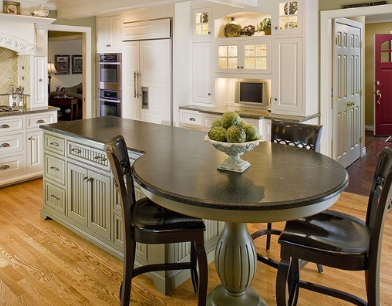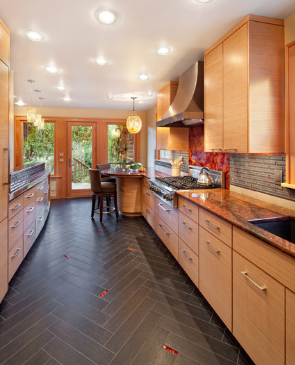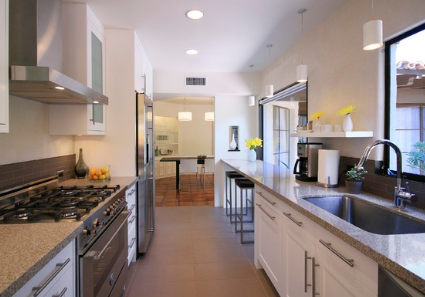Most people at least want to have a small, casual dining spot in the kitchen, even if it’s only big enough for a bar stool or two. But not everyone’s kitchen layout can accommodate seating. Or maybe you think so. Old houses, especially colonies from the 1960s and 1970s, have long, narrow kitchens at the back of the house, which are often wide enough to accommodate an island, but not enough for seating (that is, without compromising decent circulation). At the same time, by definition, the kitchen in G alley cannot include an island, so where can you put your seats?

In a Long, Narrow Kitchen
Maybe your kitchen isn’t wide enough to add seating at the back of the island, and maybe adding a full kitchen table makes things too stressful. If your room is long, consider extending an additional bar-style table at the end of the island cabinet section.

Extend the countertop to the same height as the island to make it more flexible when eating, serving, or preparing food.

In an L-Shaped Kitchen
It’s hard to find a good place to place a dining table in an L-shaped kitchen. By working around the corner, though, this small breakfast habitat bridges the ends of the L-shape while making the most of the open space.
Design Description: The base visually reduces the weight of the device.

In another L-shaped kitchen, the dilemma of where to eat is solved in a different way. The worktop extends in a gentle arc, so it can accommodate two stools without encroaching on the work area.
Design Description: Make the overhang shallow to facilitate the use of the base cabinet.

Belt Peninsula
These homeowners added a very low overhanging peninsula at the end of the peninsula for counter and cupboard space and a casual seating. The stool is placed at the end, so it doesn’t crowd the dining table area.
Design Description: Add some details like the cornice corners and curved countertops to make it look more perfect.

The kitchen is too narrow for the island, so consider adding a round or semi-circular table top at the end of the counter area – both out of the way and plenty of room for a couple of stools.
Design Description: Design the legs to match the cabinets to ensure continuity.

In this kitchen, the countertops extend to the front of the window, forming a lovely breakfast bar.
Design Description: Leave enough space between the countertop and the window to allow for clean glass and window sills. It’s also a great opportunity to connect indoors and outdoors.

Overlooking the Kitchen
Many kitchens lead to another room, but are separated by a half-wall. In this thoughtfully designed artisan kitchen, cabinetry and countertops extend outward from the walls. A cantilevered is added to the outer corners to create a breakfast bar without giving up any kitchen floor space.
Design Description: Consider the style of the stool. While a stool with a backrest is more comfortable, a stool without a backrest can be stored under the counter to save space.


